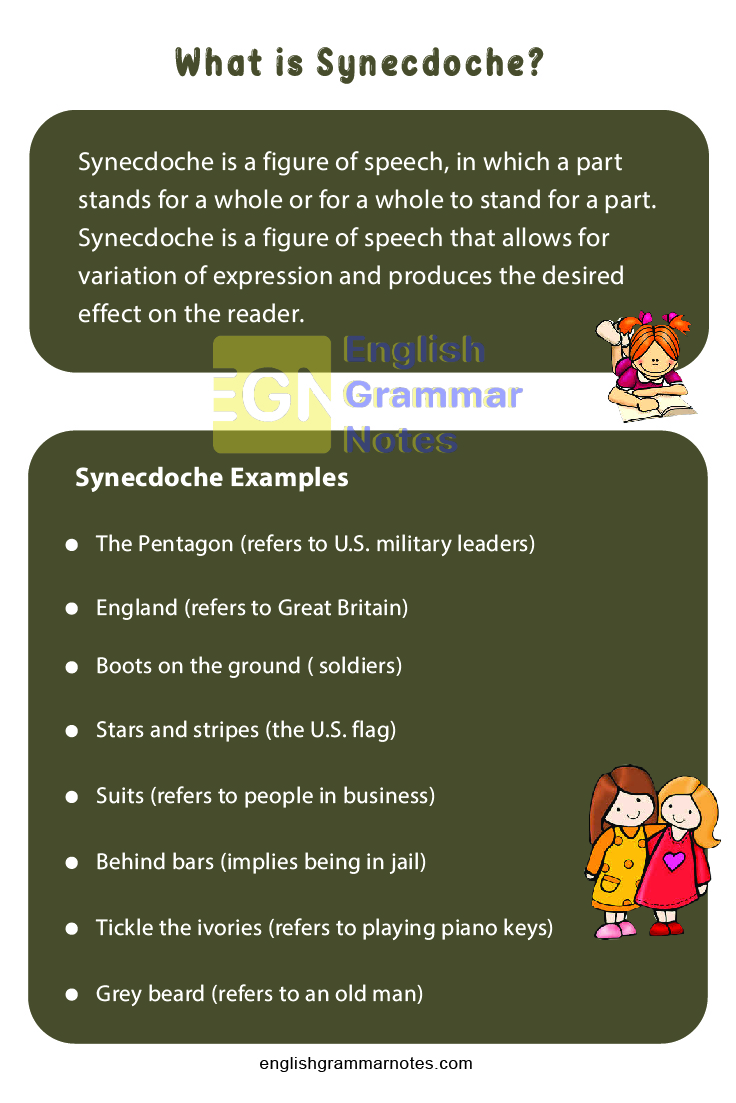Figures of speech come in different shapes and sizes. One such figure of speech is synecdoche. The word synecdoche, pronounced si-nek-duh-kee, has its origin in the Greek phrases synekdochē and ekdechesthai and means “to sense” and “to understand.” As a figure of speech, synecdoche helps in describing a word or idea in a different way. The article provides all the essential information about synecdoche including its definition, its types, common examples, its significance, etc.
- What is Synecdoche? | Definition of Synecdoche
- Features of Synecdoche
- Types of Synecdoche
- Synecdoche Examples
- Purpose of Synecdoche
- Synecdoche Vs Metonymy
- Synecdoche Synonyms
- What is a synecdoche?
- Give examples of synecdoche?
- Which are the two types of synecdoche?
- What is the difference between synecdoche and metonymy?
What is Synecdoche? | Definition of Synecdoche
Synecdoche is a figure of speech, in which a part stands for a whole or for a whole to stand for a part. Synecdoche is a figure of speech that allows for variation of expression and produces the desired effect on the reader.
Features of Synecdoche
A synecdoche will have the following features:
- One thing is named and something else is meant.
- There exists a relationship between the two elements included.
- The relation is intimate
Types of Synecdoche
Synecdoche is of two kinds.
Microcosm: It refers to a synecdoche in which a smaller part stands for a larger whole.
Example: There are about two hundred hands in this factory. Here hand refers to the whole body of a person.
Macrocosm: A synecdoche in which a larger whole stands for a smaller collection of parts.
Example: Today India will be playing with Australia. Here India and Australia refer to teams of the respective countries.
See More:
Synecdoche Examples
Given below are some common examples of Synecdoche
- The Pentagon (refers to U.S. military leaders)
- England (refers to Great Britain)
- Boots on the ground ( soldiers)
- Paper or plastic (refers to a type of shopping bag)
- Stars and stripes (the U.S. flag)
- Suits (refers to people in business)
- Wheels (refers to a vehicle)
- Pearly gates ( Heaven)
- Behind bars (implies being in jail)
- Threads (means clothing)
- Tickle the ivories (refers to playing piano keys)
- Twinkle toes (refers to a dancer)
- The White House ( the U.S. president or executive branch)
- Wearing heels (refers to high-heeled shoes)
- Grey beard (refers to an old man)
- Green thumb (refers to a person who is good at gardening)

Purpose of Synecdoche
Synecdoche is a figure of speech that has several benefits. These include:
- Captures the essence of an idea
- Synecdoche helps to emphasize certain parts of a whole, through substitution.
- The use of synecdoche also helps readers to associate concepts and ideas.
Synecdoche Vs Metonymy
Both metonymy and Synecdoche are related terms. They are both figures of speech that allow one thing to represent another. However, the difference between these figures of speech is that synecdoche substitutes a part for a whole. On the other hand, metonymy substitutes an associated idea for another idea.
Synecdoche Synonyms
A synecdoche is a figure of speech that does not have any close synonyms. Some other literary devices that are close to it include allegory, alliteration, allusion, analogy, and even anaphora. A trope or image could also be considered as its synonym.
A wide variety of English Grammar Notes and rules along with enough examples is available for students right from beginner to advanced levels and can be downloaded for free.
FAQs on Synecdoche
Synecdoche is a figure of speech, in which a part stands for a whole or for a whole to stand for a part.
2. Give examples of synecdoche?
Some common examples of synecdoche include Paper or plastic (refers to a type of shopping bag), Stars and stripes (the U.S. flag), Suits (refers to people in business), and Wheels (refers to a vehicle), etc.
3. Which are the two types of synecdoche?
The two types of synecdoche are microcosm synecdoche and macrocosm synecdoche.
4. What is the difference between synecdoche and metonymy?
A synecdoche substitutes a part for a whole. On the other hand, metonymy substitutes an associated idea for another idea.
Conclusion
Synecdoche is a common figure of speech that can be used both in day-to-day conversation as well as within written works in literature. The use of synecdoche will add a distinct flavor to words, making them appear vivid. As a literary device, it adds life to ideas and concepts. The otherwise common ideas and objects are given deeper meaning with the use of synecdoche.
